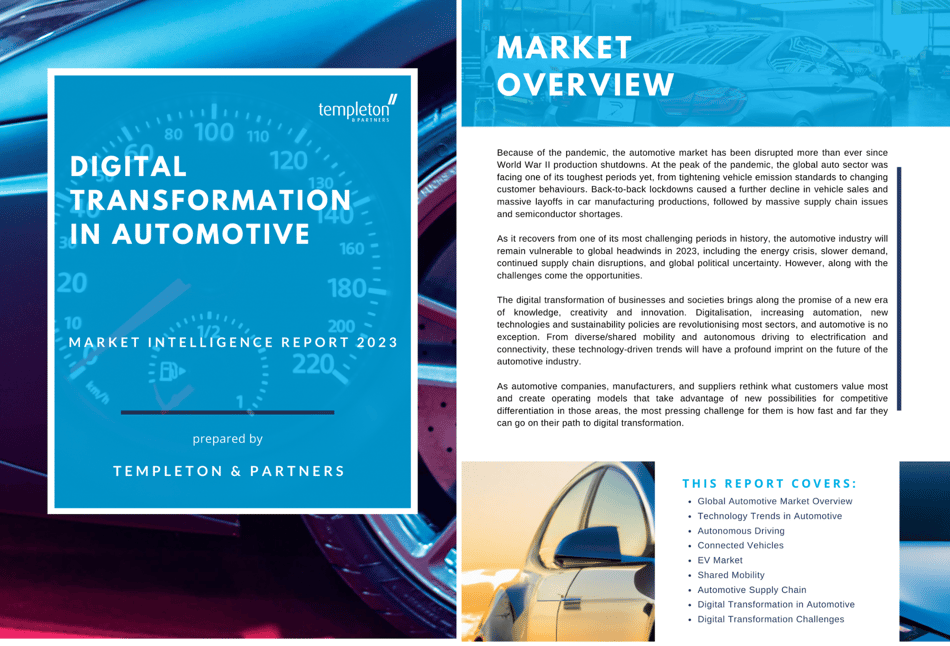Because of the pandemic, the automotive market has been disrupted more than ever since World War II production shutdowns. At the peak of the pandemic, the global auto sector was facing one of its toughest periods yet, from tightening vehicle emission standards to changing customer behaviours. Back-to-back lockdowns caused a further decline in vehicle sales and massive layoffs in car manufacturing productions, followed by significant supply chain issues and semiconductor shortages.

As it recovers from one of its most challenging periods in history, the automotive industry will remain vulnerable to global headwinds in 2023, including the energy crisis, slower demand, continued supply chain disruptions, and global political uncertainty. However, along with the challenges come the opportunities.
The digital transformation of businesses and societies brings along the promise of a new era of knowledge, creativity and innovation. Digitalisation, increasing automation, new technologies and sustainability policies are revolutionising most sectors, and automotive is no exception. From diverse/shared mobility and autonomous driving to electrification and connectivity, these technology-driven trends will have a profound imprint on the future of the automotive industry.
As automotive companies, manufacturers, and suppliers rethink what customers value most and create operating models that take advantage of new possibilities for competitive differentiation in those areas, the most pressing challenge for them is how fast and far they can go on their path to digital transformation.
Here, Templeton & Partners provides the latest UK, European and global market overview of the Automotive industry. Specifically, the report covers the following topics:
- Global Automotive Market Overview
- Technology Trends in Automotive
- Autonomous Driving
- Connected Vehicles
- EV Market
- Shared Mobility
- Automotive Supply Chain
- Digital Transformation in Automotive
- Digital Transformation Challenges
The most recent research and projections from leading publications and institutions, such as PwC, IBM, Gartner, ING, J.P. Morgan, McKinsey, ACEA, Capgemini, and Goldman Sachs, reveal expert insights into the current trends, challenges, and opportunities that will shape the future of the Automotive industry.
Download our free Digital Transformation in Automotive Market Report 2023

Global Automotive Market Overview
- Market Value – The global auto industry is worth around $3 trillion. (IBISWorld)
- Industry Projections – During the next five years, the auto industry in units will grow, but enterprise value will shrink. Unit auto sales will increase by 20 million and hit a new high at 98 million units in 2026 (IHS Markit). However, the enterprise value of global automakers is likely to drop roughly 20% to $2.8 trillion. (ARK Invest)
- Global Car Market – Global car sales will rise by approximately 4% in 2023 despite a downbeat outlook for the global economy. This is due to more consistent production volumes, the delayed demand backlog and positive growth expectations for China. (ING)
- Automotive Market Sales – As demand stabilises and inventory improves, new and used-vehicle prices are expected to ease. Prices could drop up to 5% for new vehicles and 10% to 20% for used vehicles. (P. Morgan)
- Automotive Production – In 2023, light vehicle production levels are expected to rise by 4.0%. Though semiconductor availability continues to impact production, demand constraints are expected to accelerate in the second half of 2023 and into 2024, impacting production and influencing the speed and scale of inventory restocking. (S&P Global Mobility)
- Online Vehicle Retail – Online vehicle retail, aftersales and services are forecasted to continue to acquire market share, and the global revenue from online vehicle retail is expected to increase five-fold, from $120 billion in 2018 to $605 billion in 2025. (Statista)
- New Business Models – The automotive revenue pool will significantly increase and diversify toward on-demand mobility and data-driven services. This could create up to $1.5 trillion in additional revenue potential in 2030, compared with about $5.2 trillion from traditional car sales and aftermarket products/services in 2015. (McKinsey)
- Supply Chain – In 2023, the industry may start to see a recovery of the supply chain. China is expected to open up, reducing availability issues. Freight rates are around two-thirds lower than at the start of 2022 but remain higher than in 2019. (Addleshaw Goddard LLP)
- Connectivity – By 2030, about 95% of new vehicles sold globally will be connected, up from around 50% today. (McKinsey)
- EV Sales – In 2021, global electric vehicle sales reached over 6.5 million units. By 2030, 300 million EVs are expected to be on the road (including buses, vans, and heavy trucks). (IEA)
- Shared Mobility – The Shared Mobility segment worldwide is projected to grow by 3.50% (2023-2027), resulting in a market volume of $1.79 trillion in 2027. Moreover, 66% of its total revenue will be generated through online sales. (Statista)
- Autonomous Driving – Based on consumer interest in AD features and commercial solutions available today, advanced driver-assistance systems (ADAS) and AD could generate between $300 to $400 billion in the passenger car market by 2035. (McKinsey)
Technology Trends in Automotive
- Screenification – The expansion and multiplication of screens inside cars is exponential. Volkswagen’s latest addition to its electric range features a 38cm screen and illuminated touch sliders. Peugeot’s Inception concept took a new angle with the installation of a screen into its Hypersquare control system, and Stellantis’ 1500 Revolution battery-electric vehicle (BEV) concept features a display made up of two screens. (CES)
- Mobility-as-a-Service (MaaS) – Smartphone integration and cloud computing solutions will enable automakers to progress their services and allow consumers to move their digital environment from vehicle to vehicle. Users will no longer be tied to a single vehicle. Automakers will need to supplement in-vehicle innovation with digital solutions, including advice on traffic patterns, access to other modes, information regarding optimal routes and the ability to find and reserve different vehicles. (IBM)
- Collaboration – A paradigm shift to MaaS, will inevitably force traditional car manufacturers to compete on multiple fronts. Mobility providers like Uber, tech giants like Google, and OEMs like Tesla, for instance, increase the complexity of the competitive landscape, potentially leading to consolidation or new forms of partnerships among incumbent players. (McKinsey)
- Virtual Car Showrooms – Powered by VR/AR technology and AI solutions, virtual car showrooms will play a major part in the scalability of auto sales, whether customers purchase in person or completely online. Given the greater level of buyer satisfaction, virtual car showrooms are soon going to surpass marketplaces and websites in the race for the best place to sell your cars online. (Spyne)
- Shared Mobility & Connectivity Services – The automotive revenue pool will significantly increase and diversify toward on-demand mobility services and data-driven services. This could create up to $1.5 trillion in additional revenue potential in 2030, compared with about $5.2 trillion from traditional car sales and aftermarket products/services in 2015. (McKinsey)
- Vegan-friendly Cars – A growing number of consumers are looking for ethical and green options when purchasing their vehicles. Some vegan-friendly cars in the market include the Tesla Model S, the Range Rover Velar and the Ford Mustang Mach-e. (Car Magazine)
- Natural Gas-Powered Vehicles – The automotive natural gas vehicle market size is expected to grow to $16.71 billion in 2027. Product innovations have emerged, with major market players focusing on reducing greenhouse gas emissions. For instance, in 2021, Scania, launched an LNG tractor unit for its biogas-fuelled long-distance haulage. The Scania vehicle can operate on 100% biogas, which will offer up to a 90% carbon dioxide reduction. (The Business Research Company)
- Adaptive AI – This technology allows continuous retraining models within runtime and development environments based on new data and adjusted goals. Combined with themes like wireless-value realisation (where real-time data boosts connectivity) will feature heavily in cutting-edge production environments. (Gartner)
Download the Free Market Intelligence Report to discover more on:
- Industry Challenges – How the automotive industry will keep up with the market pressures and the ongoing changes in regulations and technology?
- Key Trends – Which are the most important automotive trends, and how are they transforming the industry?
- Digital Transformation – How electrification, connectivity, automation and digitisation will impact automotive companies, manufacturers, and suppliers globally in the next years?
- Drivers for Digital Transformation – Which are the leading drivers of digital transformation in the automotive sector?
- Industry Projections – What will the future look like for the industry, and how the increased complexity of this competitive market is leading to new forms of partnerships among auto and tech incumbent players?





